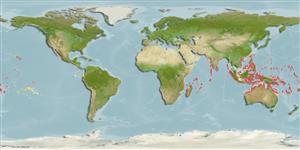Teleostei (teleosts) >
Ovalentaria/misc (Various families in series Ovalentaria) >
Pseudochromidae (Dottybacks) > Pseudoplesiopinae
Etymology: Pseudoplesiops: Greek, pseudes = false + Greek, plesios = near (Ref. 45335).
Eponymy: As the common name shows, this is a toponym after the type locality in American Samoa. (Ref. 128868), visit book page.
More on author: Schultz.
Environment: milieu / climate zone / depth range / distribution range
Ecology
Marine; reef-associated; depth range 3 - 20 m (Ref. 90102). Tropical; 25°N - 24°S
Indo-West Pacific: Maldives to Samoa, north the Yaeyama Islands (Ryukyu Islands), south to northwestern Australia and the southern Great Barrier Reef.
Size / Weight / Age
Maturity: Lm ? range ? - ? cm
Max length : 2.3 cm SL male/unsexed; (Ref. 559)
Found in inshore reefs and in caves with rich invertebrate growth in walls (Ref. 48635); feeds on benthic invertebrates (Ref. 1602). Cryptic and seldom seen (Ref 90102).
Life cycle and mating behavior
Maturity | Reproduction | Spawning | Eggs | Fecundity | Larvae
Paxton, J.R., D.F. Hoese, G.R. Allen and J.E. Hanley, 1989. Pisces. Petromyzontidae to Carangidae. Zoological Catalogue of Australia, Vol. 7. Australian Government Publishing Service, Canberra, 665 p. (Ref. 7300)
IUCN Red List Status (Ref. 130435: Version 2025-1)
Threat to humans
Harmless
Human uses
Fisheries: of no interest
Tools
Special reports
Download XML
Internet sources
Estimates based on models
Preferred temperature (Ref.
123201): 25.5 - 29.3, mean 28.4 °C (based on 2531 cells).
Phylogenetic diversity index (Ref.
82804): PD
50 = 0.5020 [Uniqueness, from 0.5 = low to 2.0 = high].
Bayesian length-weight: a=0.00447 (0.00174 - 0.01147), b=3.10 (2.87 - 3.33), in cm total length, based on LWR estimates for this (Sub)family-body shape (Ref.
93245).
Trophic level (Ref.
69278): 3.5 ±0.37 se; based on food items.
Fishing Vulnerability (Ref.
59153): Low vulnerability (10 of 100).
🛈
Nutrients (Ref.
124155): Calcium = 437 [191, 1,139] mg/100g; Iron = 1.61 [0.71, 3.25] mg/100g; Protein = 18.1 [16.7, 19.5] %; Omega3 = 0.118 [0.046, 0.321] g/100g; Selenium = 31.1 [8.6, 94.0] μg/100g; VitaminA = 141 [32, 647] μg/100g; Zinc = 4.3 [2.3, 7.1] mg/100g (wet weight);
